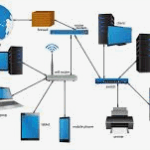
All other ICMP traffic types are denied. For example, the outside host cannot initiate a ping request to the inside host.
Mitigating ICMP Abuse
NAT and PAT
Network Address Translation
Encryption, Encapsulation, and Tunneling
Peer-to-Peer Networking and Tor
Any time that unknown users are provided access to network resources, security is a concern. File-sharing P2P applications should not be allowed on corporate networks.
P2P network activity can circumvent firewall protections and is a common vector for the spread of malware.
P2P is inherently dynamic. It can operate by connecting to numerous destination IP addresses, and it can also use dynamic port numbering. Shared files are often infected with malware, and threat actors can position their malware on P2P clients for distribution to other users.
Processor sharing P2P networks donate processor cycles to distributed computational tasks. Cancer research, searching for extraterrestrials, and scientific research use donated processor cycles to distribute computational tasks.
Instant messaging (IM) is also considered to be a P2P application. IM has legitimate value within organizations that have geographically distributed project teams. In this case, specialized IM applications are available, such as the Webex Teams platform, which is more secure than IM uses public servers.
P2P
Load Balancing
Action Point
Get My 66 Page eBook on How to Run Success Ads ON TikTok for 2,000 Naira. Click Here to Buy.
Get my 90 Page ebook on How to Run Ads on Facebook. Click here to buy now.
P.S.: If you need private online training on any of the ICT courses I offer here and you are in Nigeria, please send me a DM on my WhatsApp at +2348103180831. Please note that the Training will be 100percent online. It will be delivered via Zoom or Google Meet.
PS: I know you might agree with some of the points raised in this article or disagree with some of the issues raised.
Please share your thoughts on the topic discussed. We would appreciate it if you could drop your comment. Thanks in anticipation.




Leave a Reply